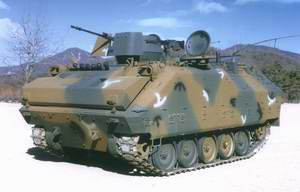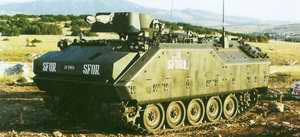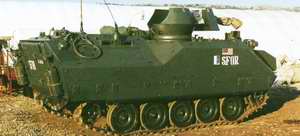| Designation: | KIFV |
 |
|---|---|---|
| Manufacturer: | Doosan Infracore Co. LTD - DI | |
| Product type: | Armoured Vehicles | |
| Name: | Infantry fighting vehicle |
In 1981, the Korean Army issued a request for proposals for a new Korean Infantry Fighting Vehicle (KIFV) and Doosan Infracore Defense Products (at that time Daewoo Heavy Industries & Machinery Ltd) was subsequently awarded a contract for development and production of this vehicle.
The KIFV entered production in 1985 and is sometimes referred to as the Type K200 and by mid-2007 it is estimated that over 2,000 vehicles, including variants, had been built for the home and export markets, production is now understood to be completed.
Based on the experience in the development and production of the KIFV, in 1994, the company developed a further model called the KIFV (K200A1). This has a number of improvements over the earlier vehicle including the installation of a 350 hp turbocharged MAN/Doosan D2848T diesel engine and a new fully automatic Allison X-200-5K automatic transmission.
It is expected that earlier K200 vehicles will be brought up to the K200A1 standard as the new power pack gives an improved power-to-weight ratio and greater acceleration. In the earlier K200 the driver used sticks to steer the vehicle but in the K200A1 he uses a steering handle, which reduces driver fatigue.
Late in 1993, Malaysia placed an order and took delivery of 42 KIFVs for use with its units operating as part of United Nations forces in the former Yugoslavia. These were delivered in 1993.
This order comprised the following versions: 32 KIFVs; 4 mortar carriers; 2 recovery vehicles; 2 command post vehicles; 2 ambulance vehicles. These were delivered in 1994.
In mid-1994, Malaysia placed a further order for 22 vehicles in the following versions: 18 KIFVs; 2 recovery vehicles; 1 command post vehicle; 1 ambulance. These were delivered in 1995.
In mid-1995, Malaysia placed a further order for 47 KIFV and variants, all of which have now been delivered.
In the future the KIFV will be supplemented in ROK service by the new Doosan Next Infantry Fighting Vehicle (NIFV), development of which was completed in mid-2007. Description
The hull of the KIFV is of all-welded aluminium armour with an additional layer of spaced laminate steel armour bolted to it. This composite armour provides a higher level of protection for less weight.
According to the manufacturer, protection from small arms fire is provided up to 0.50 (12.7 mm) armour-piercing rounds fired from the front and flanks.
The engine compartment is located at the front right of the vehicle and is separated from the remainder of the KIFV by a bulkhead. The engine compartment is fitted with a fire extinguishing system that can be operated by the driver or from outside the vehicle.
The air inlet, air outlet louvres and the exhaust pipe are located on the roof of the vehicle.
The complete power pack consists of the engine, transmission with integrated hydrostatic steering system and hydraulic service and multidisc friction brake, final drives and associated drive shaft and universal joint.
Power is transmitted through two shafts to the final drives, which can be disconnected to remove the power pack. The latest KA200A1 is powered by the German MAN D2848T V-8 water-cooled direct injection turbocharged diesel engine, which develops 350 hp at 2,300 rpm. This is manufactured under licence by Doosan.
The latest KA200A1 has the US Allison X200-5K transmission, which is an automatic shift and steering transmission with four forward gears and one reverse and a hydrostatic steering system.
The driver is seated at the front of the vehicle on the left side and has a single-piece hatch cover that can be opened upwards by means of a locking hook placed on the hatch ring.
Four M17 day periscopes are used for forward observation and a locally produced KAN/VVS-2 passive periscope can be installed in his roof hatch for driving at night.
The gunner is seated behind the engine compartment and the cupola for the gunner can be traversed smoothly through 360° even on a slope. The gunner is provided with five M17 day periscopes and a single-piece hatch cover that opens to the rear and forward mounted on his cupola is a 0.50 (12.7 mm) M2 machine gun. The gunner is provided with front, side and rear protection.
For operations in Bosnia, a number of Malaysian KIFV have had their 0.50 (12.7 mm) M2 machine guns replaced by a 40 mm automatic grenade launcher with the gun shield being retained.
To the rear of the driver is another gunner's position armed with a 7.62 mm machine gun, the cupola is similar to that fitted to the M113 series and has five M17 day periscopes and a single-piece hatch cover that opens to the rear.
The troop compartment is at the rear of the KIFV and the troops enter and leave via a hydraulically operated downward-opening ramp in the rear; this is also provided with a ramp door in the left side.
There is a roof hatch over the troop compartment that opens to the rear and in either side are two firing ports with a vision block above. There are also two firing ports in the rear ramp.
Torsion bar suspension either side consists of five dual rubber-tyred road wheels with the drive sprocket at the front and idler at the rear, which is connected to the tension adjuster to maintain track tension. There are no track-return rollers.
The first, second and last road wheel stations are provided with a telescopic shock-absorber and the steel tracks are of the single pine type, with detachable rubber pads.
The vehicle is fully amphibious, being propelled in the water by its tracks. Before entering the water a trim vane is erected at the front of the vehicle and the two bilge pumps are switched on.
The two bilge pumps are located in the bottom of the hull, below the floor level, one in the rear of the personnel compartment and the other in the front of the engine compartment. These have a total discharge capacity of 348 litres/min.
Mounted on the forward part of the hull above the trim vane is a bank of six electrically operated smoke grenade launchers that fire forwards. Variants
This has been developed to meet the technical requirements of the battlefield environment for NBC warfare. Equipment fitted includes NBC detection equipment such as mobile mass spectrometer (MM-1), collective overpressure system, contamination marking set and a weather observation system.
This is similar to the standard K200A1 but in the rear is fitted a turntable-mounted 107 mm (4.2 in) mortar which fires through the roof, which has a three-part hatch. If required, the mortar can be dismounted for ground use. In total, 88 rounds of 107 mm ammunition are carried, with a pintle-mounted 0.50 (12.7 mm) M2 machine gun provided for local protection.
This is basically the K200A1 chassis fitted with one-man electrically powered turret which is armed with a 20 mm M168 Vulcan cannon. Turret traverse is 360° with weapon elevation from -5 to +80° and turret traverse through a full 360°. The gunner can select either 10, 30, 60 or 100 round bursts. This system has a four-man crew and a combat weight of 13,200 kg. Full details are given in Jane's Land-Based Air Defence. This model is in service only with South Korea.
This has a similar chassis to the K200A1 except that it has a raised hull rear for increased accommodation. The vehicle has a six-man crew consisting of driver, radio operator and four additional crew members.
The command post vehicle is equipped with map boards, tables, an NBC detection unit and an auxiliary power unit to provide current electrical power. A tent can be erected at the rear to provide more space for the command personnel.
Armament consists of a pintle-mounted 0.50 (12.7 mm) M2 machine gun and a bank of six forward-firing electrically operated smoke grenade dischargers.
This is similar to the standard K200A1 but in the rear is fitted a turntable-mounted 81 mm mortar which fires through the roof, which has a three-part hatch cover. If required, the 81 mm mortar can be deployed away from the vehicle. A total of 114 rounds of 81 mm mortar ammunition are carried with a pintle-mounted 0.50 (12.7 mm) M2 machine gun provided for local protection.
The K288A1 recovery vehicle is based on the chassis of the K200A1 and is equipped with a hydraulically driven winch for the recovery of damaged and disabled vehicles.
Mounted either side of the hull at the rear are spades which are lowered to the ground during operations. An auxiliary spade unit, carried on the roof when not required, can be used between the two spades in soft soil.
The winch is fitted in the rear crew compartment and has a direct maximum capacity of 10,000 kg, although this can be increased to 20,000 kg by use of a snatch block.
Mounted on the left side of the hull roof is a crane, which can lift a load of 6,000 kg through a full 360°.
The four-man crew consists of commander, driver, operator and mechanic. There is provision for mounting a 12.7 mm M2 machine gun at the commander's cupola on top of the superstructure and six smoke grenade dischargers are mounted on the front of the hull.
This was developed as one of a series of vehicles for the Malaysian battalion UN peacekeeping forces in Bosnia. The crew compartment of the vehicle is furnished to stow the equipment for medical treatment of wounded troops.
Equipment carried includes four litter sets, two sets of automatic oxygen resuscitators and two splint sets. Exterior configuration is identical to the standard vehicle.
This is fitted with a one-person power-operated turret armed with a stabilised 25 mm cannon and a 7.62 mm coaxial machine gun. This version has not so far entered quantity production.
This model has been developed as a private venture for the export market and is fitted with a one-man AV30 turret armed with a 30 mm ATK Gun Systems Company M230 Chain Gun with a 7.62 mm M240 coaxial machine gun.
Prototype only. Did not enter service.
This has also been developed as a private venture for the export market and is fitted with the German Mauser MT30K turret armed with an externally mounted 30 mm Mauser MK 30 cannon with a 7.62 mm MG3A1 machine gun being mounted coaxial.
Prototype only. Did not enter service.
This is fitted with a one person turret designed by Doosan and armed with one 40 mm grenade launcher K4.
Prototype only. Did not enter service.
This has been developed as a private venture for the export market and is fitted with a two-man turret armed with a CMI Defence 90 mm gun, 7.62 mm coaxial machine gun and a commander's ring with a 7.62 mm machine gun.
Prototype only. Did not enter service.
Early in 2000, the now Doosan proposed to the Royal Malaysian Army that its current K200 KIFV could be upgraded to the enhanced K200A1 standard in Malaysian Army facilities in a very short period of time.
This offer was accepted and the task carried out by Number 91 Workshop of the Royal Malaysian Army which dismantled the vehicle, carried out modifications to the hull and fitted the new power pack.
As the new power pack is slightly larger, the bulkhead has to be taken out and positioned 75 mm to the rear and there are also a number of small electrical changes. The final drives have also been changed to take into account the increased engine output available.
Work started on 28 February and the vehicle ran for the first time on 30 March and then made its first public appearance at the DSA 2000 exhibition held in Kuala Lumpur in March 2000.
The installation of this new power pack not only improves the power-to-weight ratio of the vehicle from 21.7 hp/t to 26.5 hp/t but also improves acceleration. Maximum road speed is now increased to 70 km/h. Braking is also improved.
It was then demonstrated to the Royal Malaysian Army at its armour school at Port Dickson. Following trials with the first prototype, another five conversions have been made in Malaysia. These are expected to be followed by another 51 to bring the total up to 57 units.
Details of the Doosan family of armoured fighting vehicles are given in a separate entry.
Vehicles based on this larger and more powerful chassis include the Flying Tiger twin 30 mm self-propelled anti-aircraft gun system, Pegasus surface-to-air missile system and the Field Artillery Ammunition Support Vehicle. It is understood that these vehicles entered service with the Republic of Korea Army late in 1999. These vehicles have been offered on the export market but there have been no known sales to date.
|
||||||||||||||||||||||||||||||||||||||
|
|||||||||||||||
|
|||||||||||||||
 |
 |
 |


